In recent years many software providers have helped to address this concern, helping with eye strain and sleep patterns. F.lux is perhaps the most noteworthy of the bunch, as their application single-handedly brought the topic to the table among techies who have slowly but surely started adopting it years ago.
Major operating systems have also begun building in an option for filtering out blue light, including Windows 10 (with the Fall Creators Update), macOS, Apple iOS, Android, and Amazon's Fire tablets.
Even though the initial impression of the yellow hue effect might shock you, your eyes will ease into the change. Once the colors settle in, you won't want to go back to the regular colors during the night as they difference in eye strain will be significant.
We'll provide brief walkthroughs for some of those operating systems, but F.lux has been around for about a decade now and is available on every major platform (download here). The software uses your location to match the sun cycle in your area, gradually adjusting your display color from 6500K (daylight) to warmer colors with less blue light as nighttime approaches.
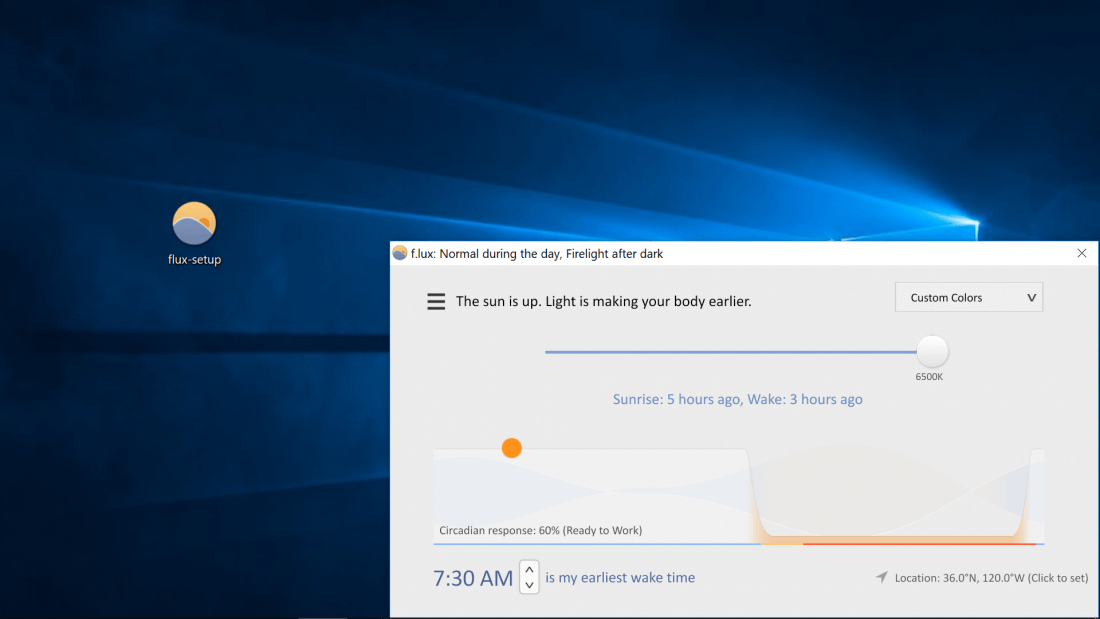
You can also manually change the temperature of your display between eight different colors, 6500K (daylight) being the brightest (blue/white) and 1200K (described as "ember") being the dimmest (orange/yellow).
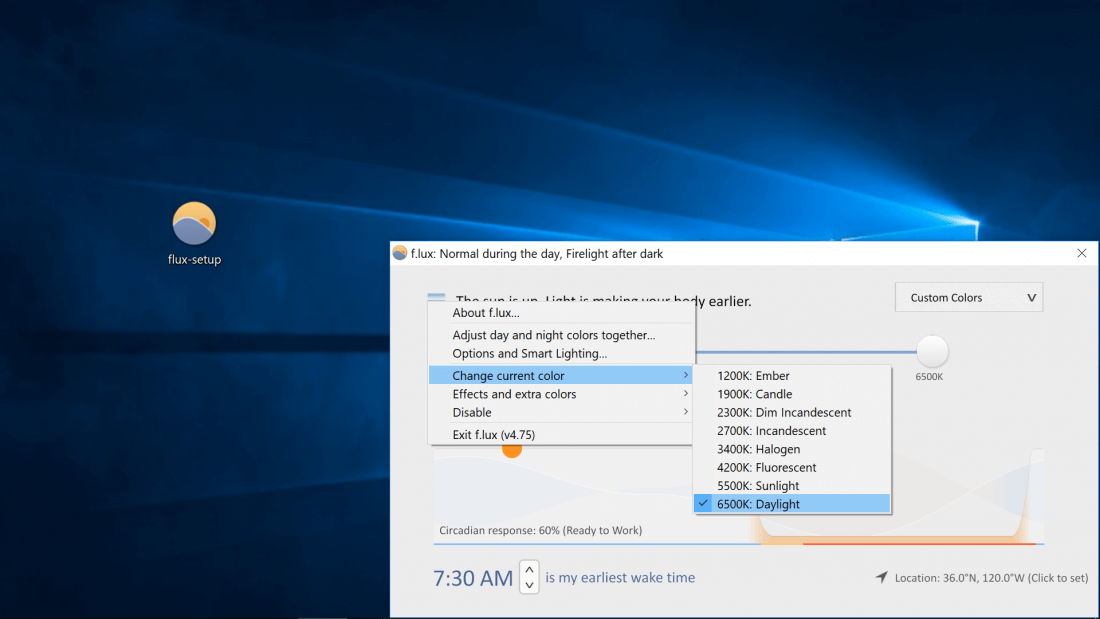
This can be reduced further by using the "Himalayan Salt Lamp" setting found under "Effects and extra colors." Other effects include "Darkroom mode" which makes your background black and text/interface red, "Emerald City" which applies a green tint, and "Soft White" which makes the daylight hue less fatiguing in our opinion, and it can be used in conjunction with the "Reduce Eyestrain" profile option.
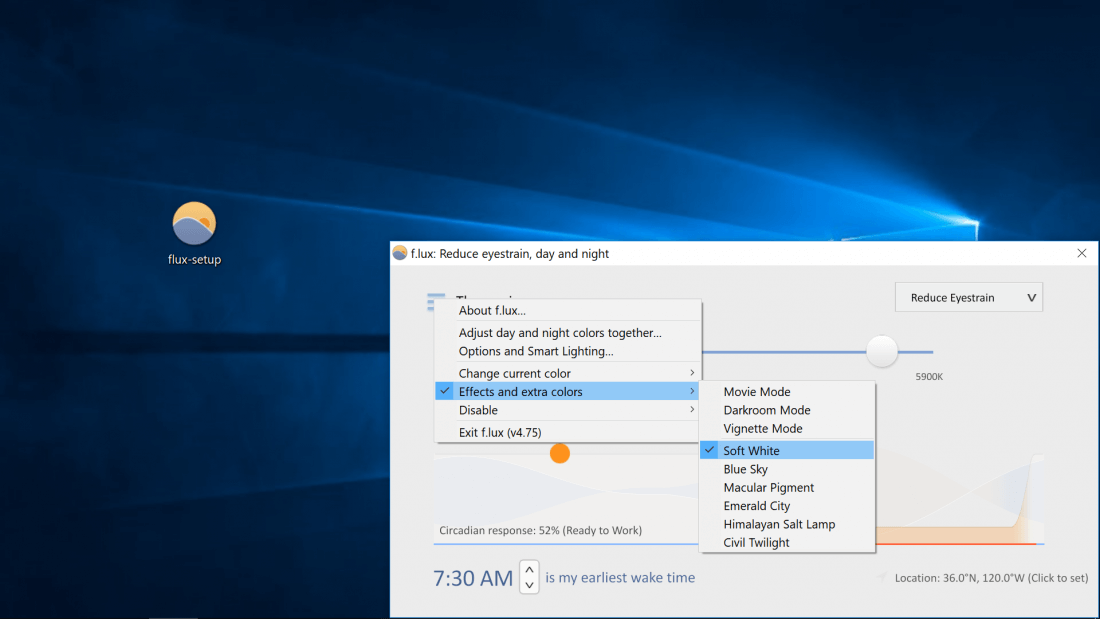
Of note, F.lux can be enabled/disabled with hotkeys and you can set it up so it disables itself automatically when you switch to and from specific applications (say, Photoshop or something where you need the color accuracy).
For those of you with connected lighting systems, the software lists support for Philips Hue, Philips ColorKinetics intelliWhite, YeeLight and LIFX.
Other alternatives to F.lux: SunsetScreen | Iris | Redshift
Folks with the Windows 10 Creators Update can enable the "Night light" feature found in Settings > System > Display, which will automatically apply a similar filter to your display as the sun sets and then remove it at the sun rises.
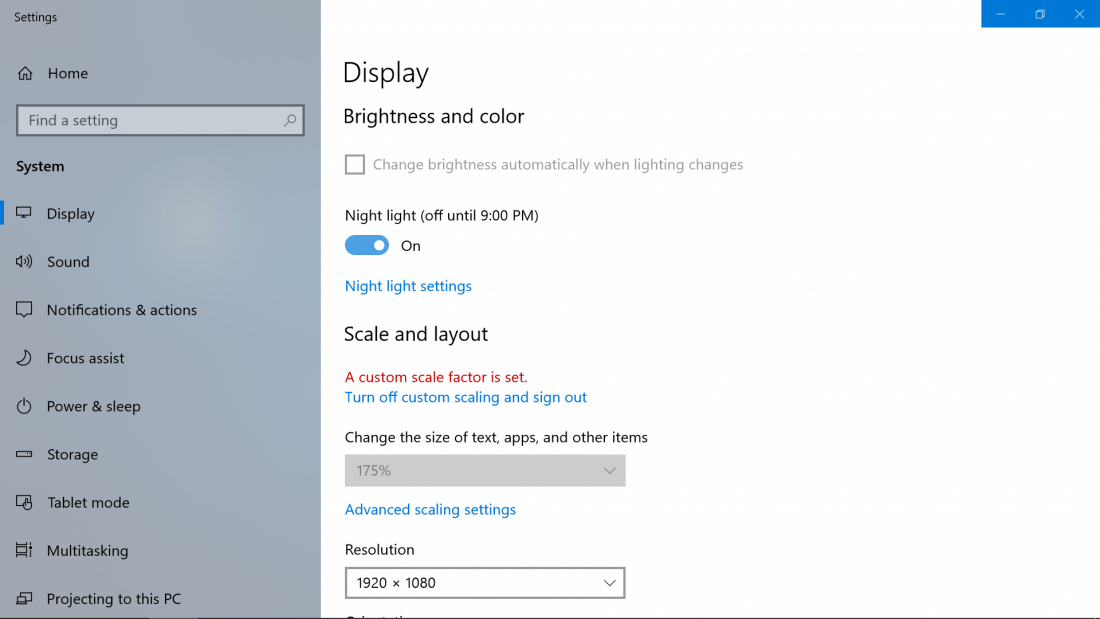
Along with the ability to set custom hours, you can tweak the temperature of the filter with a manual slider in "Night light settings" and the feature can be enabled/disabled without returning to the settings by using the button in the Action Center (beside the Windows clock).
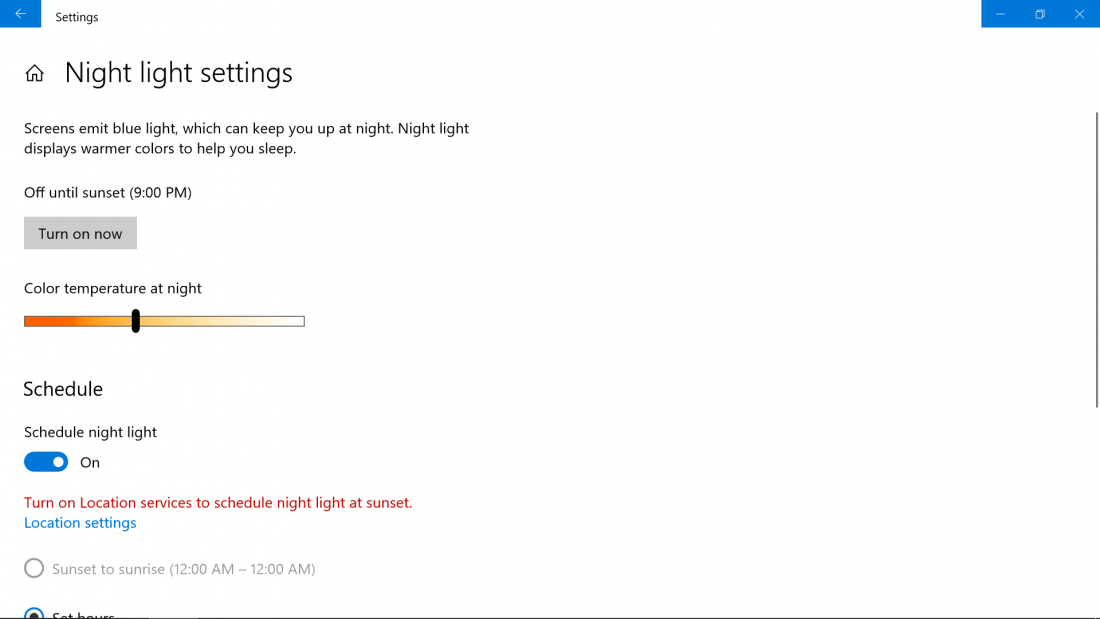
MacOS users from Sierra 10.12.4 onward have an option called "Night Shift" which can be found by navigating to SystemPreferences > Displays > Night Shift (tab)and provides about the same level of functionality as already described for Windows 10.
Night Shift is also available on select iOS devices (iPhone 5s onward, iPod Touch 6G, iPad Air and newer, iPad Mini 2 and newer, and iPad Pro), head to Settings > Display & Brightness > Night Shift.

Android N (or better) provide a "Night Light" feature. The actual name might vary depending on your phone's manufacturer but you should be able to make it out. Head to the Notifications menu >Gear icon > Display > Night Light.
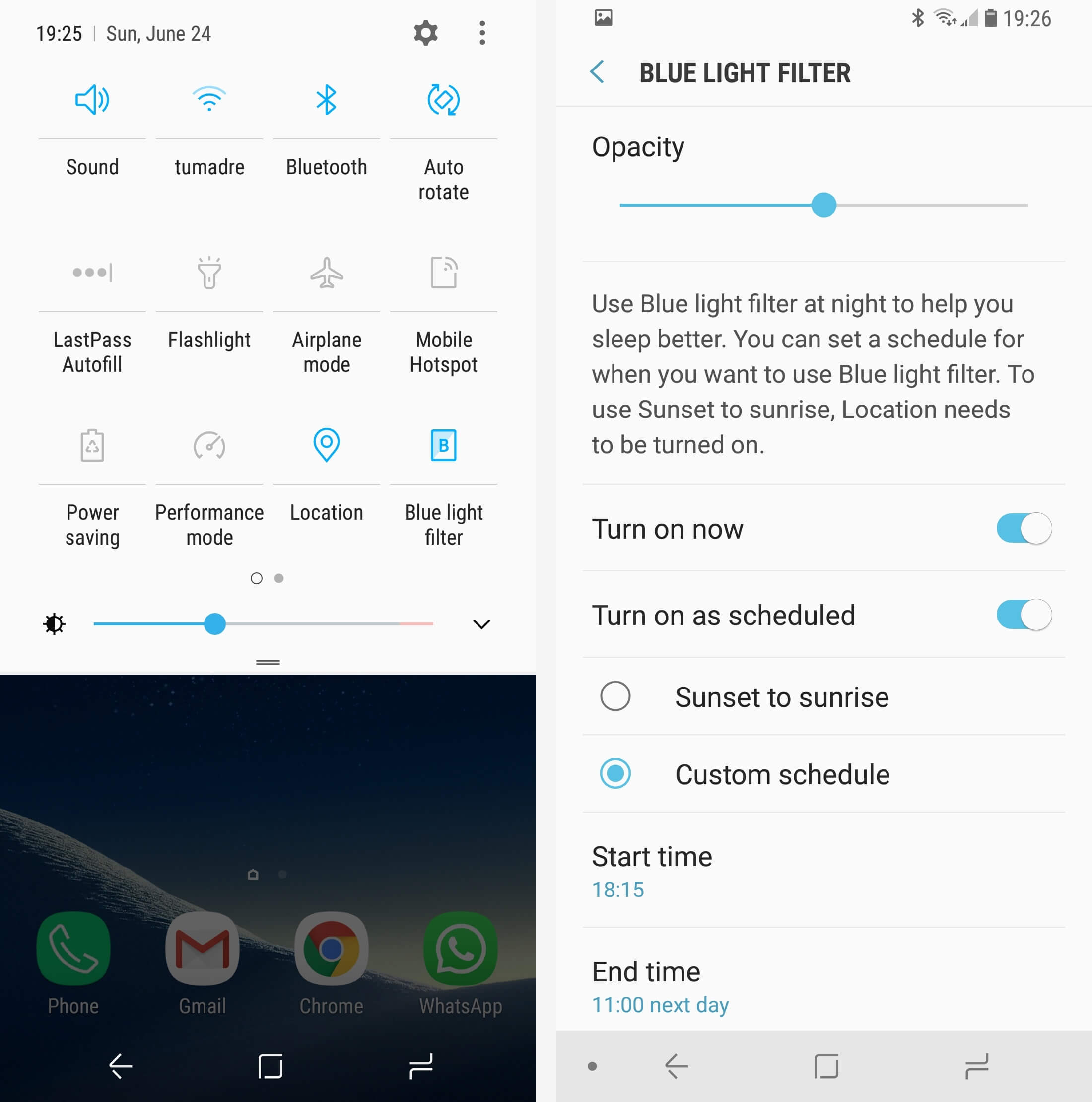
Amazon Fire tablet owners... head to Notifications menu > Settings > Display > Blue Shade.
Masthead photo: Jack Daniel Ocampo Palacios on Unsplash
 Best Garmin deal: Save over $100 on Garmin Forerunner 955
Best Garmin deal: Save over $100 on Garmin Forerunner 955
 iPhone 8 sounds like it'll share design similarities with the iPhone 4
iPhone 8 sounds like it'll share design similarities with the iPhone 4
 The rise of Pepe the Frog is another sign of hate festering online
The rise of Pepe the Frog is another sign of hate festering online
 'Hamilton' alum Leslie Odom, Jr. to use his powers for good on a Christmas album
'Hamilton' alum Leslie Odom, Jr. to use his powers for good on a Christmas album
 Today's Hurdle hints and answers for March 18, 2025
Today's Hurdle hints and answers for March 18, 2025
 The first 'Survivor: Millennials Vs. Gen
The first 'Survivor: Millennials Vs. Gen
 Sia announces deluxe edition of 'This Is Acting'
Sia announces deluxe edition of 'This Is Acting'
 Developer breaks 'The Simpsons' down by the numbers
Developer breaks 'The Simpsons' down by the numbers
 Draper vs. Arnaldi 2025 livestream: Watch Madrid Open for free
Draper vs. Arnaldi 2025 livestream: Watch Madrid Open for free
 The cancer empathy cards that say more than just 'f**k cancer'
The cancer empathy cards that say more than just 'f**k cancer'
 Operation Rock Wallaby rains food down on wildlife hurt by bushfires
Operation Rock Wallaby rains food down on wildlife hurt by bushfires
 Samantha Bee's entire staff gives Trump the finger for his comments about women
Samantha Bee's entire staff gives Trump the finger for his comments about women
 Koala tries its best to cling onto branch in the midst of intense storms
Koala tries its best to cling onto branch in the midst of intense storms
 Social media documents New Jersey train crashing into station during rush hour
Social media documents New Jersey train crashing into station during rush hour
 Nvidia RTX 5070: Where to buy and is it worth the upgrade?
Nvidia RTX 5070: Where to buy and is it worth the upgrade?
 Trump pushes conspiracy that Google suppresses negative news about Clinton
Trump pushes conspiracy that Google suppresses negative news about Clinton
 Court upholds right to take selfies in the voting booth
Court upholds right to take selfies in the voting booth
 'Star Trek' cast and crew takes a public stand against Donald Trump
'Star Trek' cast and crew takes a public stand against Donald Trump
 UGREEN Nexode 25000mAh 200W power bank drops to $79.99 at Amazon
UGREEN Nexode 25000mAh 200W power bank drops to $79.99 at Amazon
 This iPhone 7 case brings back the missing headphone jack
This iPhone 7 case brings back the missing headphone jack
Apple Pay: You can finally use it at this popular homeStaff Picks: Spines, Spaniels, and Sparsity by The Paris ReviewRedux: Film Is Death at Work by The Paris ReviewToys under $20 at Amazon — Dec. 2023 dealsOn Davenport (Who Also Wrote Well about Art) by Lucas ZwirnerStaff Picks: Cinema, Sebald, and Small Surprises by The Paris ReviewPoets on Couches: Stephanie Burt by Stephanie BurtAmerica Infected: The Social (Distance) Catastrophe by J. HobermanSleep and the Dream by László F. FöldényiLong Weekend by Michael DeForgeShirley Hazzard’s Ethics of Noticing by Michelle de KretserOn the Timeless Music of McCoy Tyner by Craig Morgan TeicherRedux: Film Is Death at Work by The Paris ReviewMickey Mouse is finally, kind of, becoming public domainNYT's The Mini crossword answers for December 24Influencers in Islamabad by Sanam MaherW. H. Auden Was a Messy Roommate by Seamus PerryQuarantine Reads: The Unconsoled by Emma GarmanWhiting Awards 2020: Genevieve Sly Crane, FictionHow to watch OSU vs. TAMU football livestreams: kickoff time, streaming deals, and more Kiki Smith: “Portraits, Celestial Bodies, and Fairy Tales” Photos from Our 2017 Spring Revel When Paula Wolfert Worked for The Paris Review Whiting Awards 2017: Simone White, Poetry What Does It Mean to Be Smart? Five Koans on Intelligence Three Kafkaesque Short Stories By … Franz Kafka Times Are Hard, But At Least Our Wallpaper Is Arsenic Taking to the Streets? Don’t Bring a Sign—Bring a Painting “Between Blossoms”: Elusive Photographs by Shen Wei An Empty Saddle for Yevgeny Yevtushenko, Cowboy Poet Making Theater: An Interview with Elizabeth LeCompte “And I’d Do It Again”: Aimée Crocker and the Art of the Heiress Best Android Smartphone Battery Life How ‘Les Misérables’ Was the Biggest Deal in Book History Why We Keep Looking for Lost Jungle Cities “A Song and the Sultan”: A Poem by Mahmoud Darwish Someone Stole the World’s Largest Gold Coin—Let’s Do It Again Staff Picks: Taipei Story, Robert Altman, Samantha Hunt, and More The Best Video Game Handguns Yevgeny Yevtushenko, “Olympic Champion of Poetry”
2.5819s , 10158.4765625 kb
Copyright © 2025 Powered by 【Imaginary Sex With A Woman Who Does Anything】,Prosperous Times Information Network